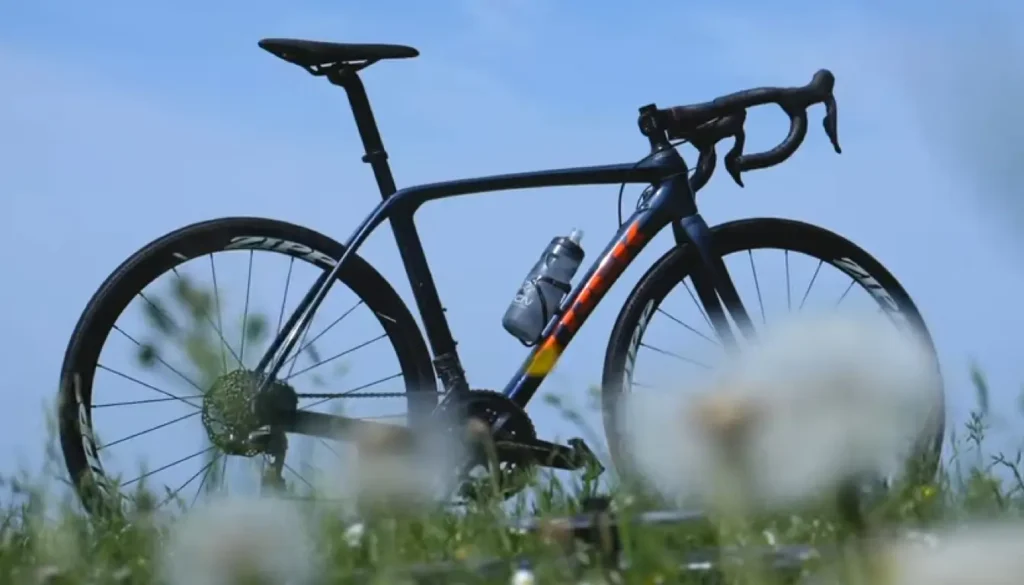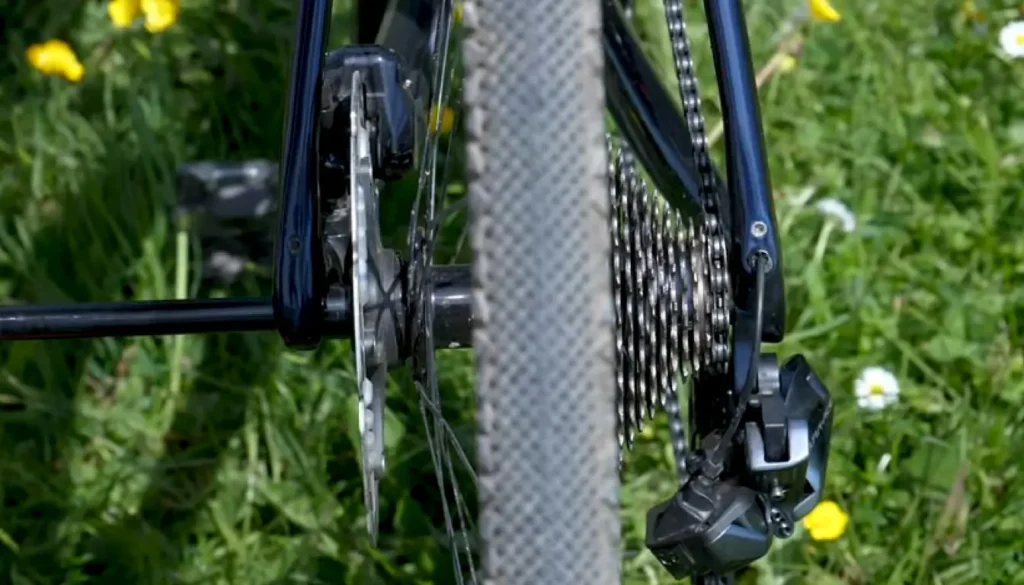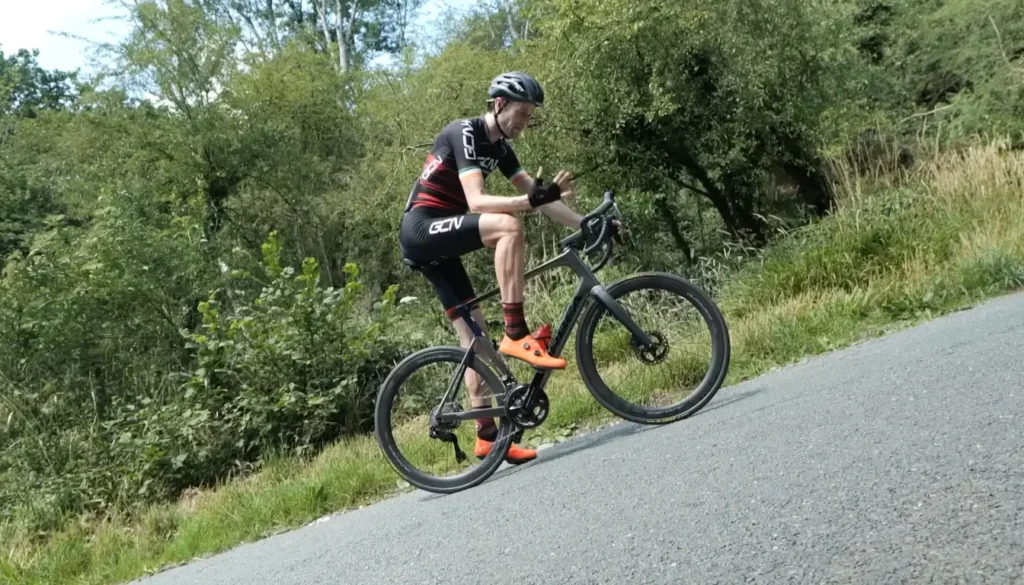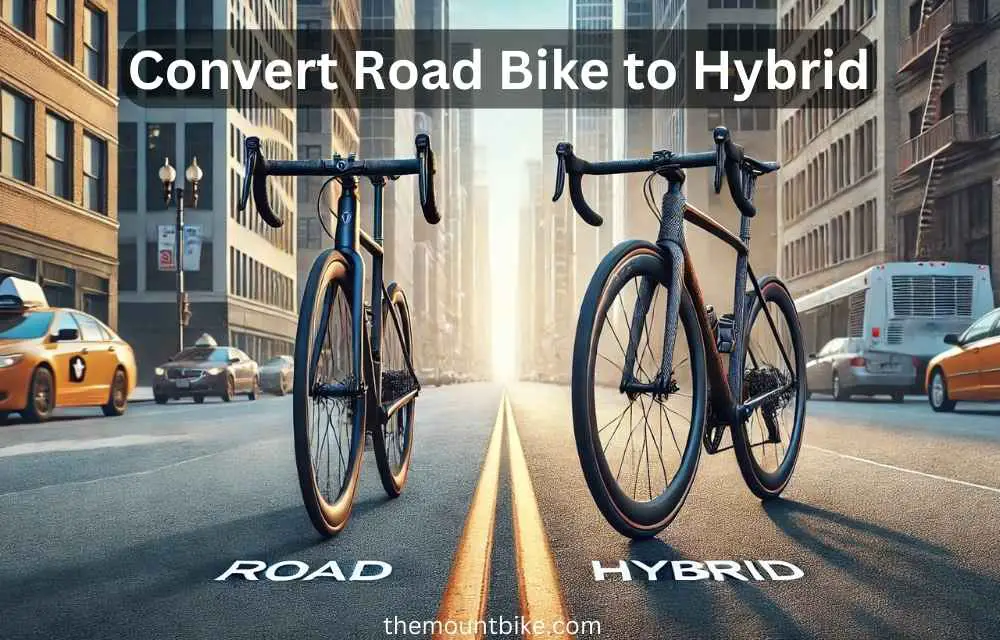A road bike is excellent for riding flat city roads on everyday commuting. But a hybrid bike is versatile to ride on various terrains, with higher speed and performance.
So lots of cyclists want to upgrade their road bikes to hybrid to enjoy their versatility without purchasing a new one.
But, they aren’t sure if it is possible to convert a road bike to a hybrid and how to do that.
This post is tailored to let you know about converting your road to a hybrid bike. Possibility. Process. Cost. Skill. Time. Worthiness. Etc.
Keep reading and discover all the factors.
Can A Road Bike Be Converted Into A Hybrid Bike?
Yes, a road bike can be converted to a hybrid bike, and there are many logical reasons. Let me explain in simple words
- Road and hybrid bikes are two kinds of bikes. They share many similarities in their construction, structure, geometry, and other basic things.
- However, there are also some dissimilarities between them. Their tire width, handlebar position, and saddle are the main differential features.
- So, you can just convert a road bike to a hybrid bike by upgrading their dissimilar components.
Have you got the points? Hopefully, yes.
Why Should You Convert Road Bike To Hybrid?

Converting your road bike to a hybrid bike will offer you some extra benefits that take your riding experience to an advanced level. Such as
Performance On Versatile Terrain
The road bike only offers you smooth rides on the city or flat roads. You have to struggle to ride it on gravel paths, off-road trails, or rough roads. It is because road bikes come with narrow tires. But when you convert it to a hybrid bike, it’ll ensure smooth rides on all types of terrain including gravel paths and uphill climbing because of its wider tires and suspension.
Enhance Durability
Due to high-pressure narrow tires, your road bike can’t absorb heavy bumps and vibrations. They’ll be prone to getting flat or punctured for these rides. But, in a road bike, its lower pressure wider tires will be compatible with wet, sandy, bumpy, or harsh conditions and ride without any risk of tire puncturing.
Increase Your Riding Comfort
The road bike’s saddle is narrow and there is no heavy padding. Even its drop handlebars aren’t adjustable for your riding position. As a result, you find your road bike is uncomfortable for longer rides.
On the other hand, you attach a highly padded saddle to replace the poor one. It’ll be comfortable to sit. And its upgraded upright handlebars will help you to get your required riding position with better visibility to ride longer without any back or waist pain.
Safety Rides
Your poor road bike has rim brakes that will offer you precise stopping power on dry roads. But on a wet surface, they won’t provide as much precise break as you need to ride safely. After converting those rim brakes into disc or hydraulic brakes, you can enjoy more reliable stopping power in all riding conditions.
Commuting
If your riding path involves unpaved or rough roads, your road bike won’t be appropriate for everyday commuting. Because, most of the time, you have to carry some belongings for regular commuting time. As the road bike won’t have racks, you can’t carry anything. And due to not having fenders, if you ride on wet roads, dirty things will splash onto your clothes.
But when you upgrade it to a hybrid bike with racks, fenders, and panniers, you can carry your belongings, and because the bike has a fender, road dirt won’t spread to your clothes.
How To Convert Road Bike To Hybrid?

Upgrading your road bike to a hybrid bike isn’t simple. It requires mid-level bike-repairing mechanical knowledge, skills, and specialized tools. However, that doesn’t mean it’s not too difficult.
Managing some time, and tools, and acquiring some skills will be worthy enough to do the job. Let’s see the step-by-step instructions.
Step 1: Assess Your Bike
First, you have to check if your bike’s condition is good enough to convert to a hybrid bike that will be worth your time, money, and energy investment. To assess your bike
- Check the bike’s frame, and fork, if they are durable for the conversation.
- Determine if there is enough space to put wider tires.
- Check the mounting points to put racks fenders and other accessories.
Step 2: Make A Shopping List & Buy Them
After assessing your bike, if you find it worthwhile to convert. Now it’s time to make a shipping list and buy the necessary equipment. However, it depends on your bike’s condition. But still, some of the accessories are universal that you must need. Such as
- A pair of a wider tire
- Hybrid handlebars
- A highly padded saddle
Some of the accessories are optional, and you can buy them for a better experience.
- Brake levers
- Stem
- USB chargeable Light
- Bell
- Shifters
- Racks and panniers
- Pedals
- Grips
Tips:
When buying the accessories, you should ensure these are compatible with your road bike and are of good quality.
Step 3: Tools Arrangement
Before jumping start to the conversion process you have to arrange some required tools. For example
- Allen keys and an adjustable wrench to remove older components and adjust the new components on your bike.
- Tire levers to replace older tires and set wider tires.
- Cable cutters to cut and connect cables and housings.
- Screw drivers to adjust discs or derailleurs brakes and other components.
- Bike stand to elevate your bike during adjustments.
- Grease and lubricants to inject in bearings, cassettes, and other moving parts.
Tip: You don’t have anyone on the list, you should include it in your shopping list and buy. You may think it’s an extra expense. But, as you have a bike, you will need these many times for DIY work. So, don’t count it as a cost, instead, think of it as an investment.
Step 4: Replace The Main Components
It’s the first step of your main job. Now you have to remove one component of the bike and install the new one. You can follow this sequence
- Set up your bike on the bike stand to elevate it.
- Remove the front and rear tires and install the new ones.
- Remove the stem, brakes, handlebars, and saddle.
- Replace them one by one ensuring correct height adjustment and angle for your body.
Step 5: Add Accessories
If you want to attach accessories like racks, fenders, bells, and lights. This time you have to install these. As they all are new and there is no hassle of removing old accessories, you can do it easily.
- First, securely Install racks, and fenders ensuring they won’t come in contact with tires when moving.
- Then attach a light and bell with easy accessibility when riding to operate them.
Step 6: Make It Ready To Test
Before getting down the bike from the bike stand, you have to get it ready to test ride.
- Inject oil into the bearing, chain, cassette, and other parts for smooth movement.
- Wipe off the bike with a dry rug to clean the dust and dirt.
- Then remove it from the bike stand.
Step 7: Test The New Hybrid Bike
So, it’s time to test your new upgraded hybrid bike. So that, you can check whether all the components are securely attached and properly functioning. Even if there is any limitation, you can get the chance to adjust it.
- Seat on the bike and check your riding position adjusting the saddle and handlebars.
- Ride the bike in an open space for 5-10 minutes.
- During the ride, check tire pressure, gears, brakes, and other necessary component adjustments.
- If everything is OK, congratulations you have done the job.
- If not, determine the flaws and properly attach them.
Is It Worth Converting Your Road Bike To A Hybrid Bike?

After reading the process, you may predict that converting your bike is a big deal. So, let’s see if it is worth the job or not. We’ll discuss the worthiness from three different angles.
Cost
There is no fixed cost to convert a bike, as different ranges of bike components are available in the market. And we don’t know which components you use and what’s their price. However, here is an overall cost estimation.
- 2 Wider tires: $40 to $160
- Hybrid handlebars: $20 to $50
- Stem: $10 to $50
- Saddle: $20 to $100
- 2 Brake levers: $40 to $100
- 2 Shifters: $40 to $300
- 2 Fenders: $20 to $50
- Racks and panniers: $30 to $200
- Pedals: $10 to $50
- Grips or tape: $10 to $30
- USB chargeable lights: $20 to $80
- Bell: $10 to $30
That means you have to spend $250 to $1100 for a complete conversation. And if you need to hire a professional mechanic then the extra cost will be $200-$300.
Performance
You’ll get comfortable, enjoyable, and reliable performance from the bike due to its wider tires, disc brakes, and suspension. This time you won’t care about the road conditions, whether it is sandy, wet, or gravel. You can ride the bike for commuting, touring, or recreational purposes.
Durability
If your bike is of good quality, and you install high-quality components and accessories. In that case, your converted hybrid bike will be as durable to last longer as many other hybrid bikes.
Overall, from all the circumstances, we can say it’s worthwhile to convert your old road bike to a new hybrid bike.
Is It Wise to Convert Your Road Bike To a Hybrid Bike, Or Should You Buy A New Hybrid Bike?
It depends on your personal preference and budget. So it’s difficult to suggest to you any decision. Rather we can discuss when to convert and when to buy. So that, you can easily make your own decision.
Cost Vs Emotional Attachment
After the market analysis, we have found that a hybrid bike costs you from $250 to $1600. That means the cost is overall the same as the conversation.
So, if you have some good memories with your road bikes. Such as your beloved one gifted you, it was connected with your emotions, or anything else, you should convert your bike. But, if nothing is like this, you should buy a new hybrid bike.
Performance Vs Hassle
Converting your old road bike to a new hybrid bike will offer you versatile and comfortable rides. But, in some cases, you have to go through frequent try and error to perfectly and adjustably set the components and accessories. When you buy a new hybrid bike, there is no other hassle like this. You just need to order, receive, and ride. As simple as that.
Reliability Vs Warranty
Yes, you can rely on your new hybrid bike as long as you use the right and high-quality components. Because you know their sturdiness. But, it won’t offer you any warranty against your conversation. In some cases, you get the warranty for that particular component, if anyone comes with a warranty. Which is very tedious to get.
On the other hand, buying a new hybrid bike must offer you a minimum of 1 year of warranty. So you can be tension-free for that time frame in case of any damage. Because the manufacturer company will take responsibility for the materials and workmanship defects.
So, if you like to enjoy the warranty, buying a new one is a good choice. But if you are confident enough about your converting bike, you can convert.
DIY Skill vs. Ready Ride
Having DIY skill sets will boost your confidence, hassle handling efficiency, and make you stronger physically and mentally. So when you convert your road bike to a hybrid bike, you’ll enjoy inner peace of mind that you have done the job. Overall it’s a lifelong skill.
On the other hand, buying a new hybrid bike offers you the motivation to be ready to ride. No old bike assessment, no shopping list making, buying them, no hassle of managing time for conversion, etc.
This means if you want to polish your DIY skills, converting the old bike is a good option. And, to avoid all those tasks, buying a new one is a good idea. So, ultimately, think about all the things, find your preference, and make your decision. Whatever you decide, we wish you a safe and sound ride every time.

I am Ryan Ford, a mountain biking enthusiast who loves to explore the outdoors. I also like to go on adventures with friends and anything else that involves being outside. I love my bike because it gets me out of the house and gives me an opportunity to enjoy nature.

